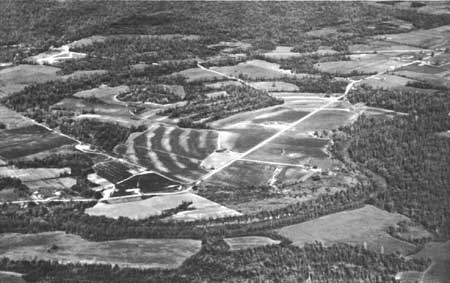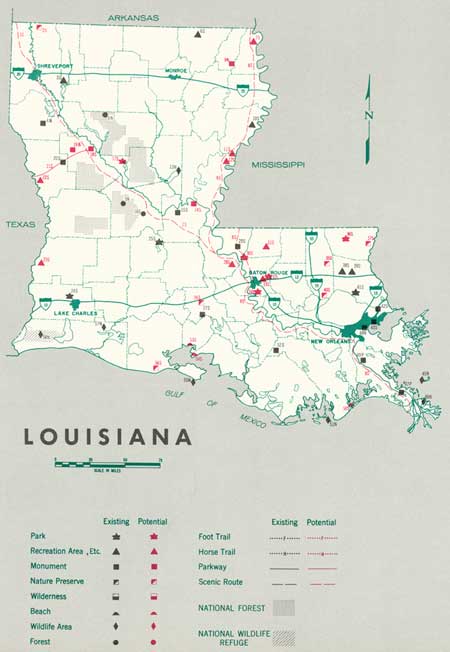.gif)
Parks for America
MENU
|
Parks for America
|

|

|
| An aerial view reveals the circular pattern of ancient Indian earthworks at Poverty Point, La., a potential national monument. (JUNIUS B. BIRD, AMERICAN MUSEUM OF NATURAL HISTORY.) |
LOUISIANA
LOUISIANA lies wholly within the Gulf Coastal Plain. The rolling, forest-clad hills of northern Louisiana contrast sharply with the lush bayous of the southern portion.
The 1960 population was 3,257,022, an increase of 21.4 percent over 1950. Projections indicate 4,114,000 people by 1976. Sixty-three percent of the population was urban in 1960. The average density was 72 persons per square mile. Greatest concentrations are in the New Orleans-Baton Rouge area and in the Shreveport area.
The tourist industry, valued at $499 million in 1959, ranks fifth in importance in the State's economy.
Roads furnish generally good access to the State's recreation areas, except in the lower bayou country. Rail and air service is important in bringing visitors to the New Orleans area. Although new interstate highways will increase east-west movement, lack of a north-south interstate may have an adverse effect on travel from the north.
Water-based recreation is extensive, with activities on the Mississippi River and other streams, the gulf coast, lakes, and bayous. The gulf coast is a major winter objective for geese and ducks on the Mississippi flyway and the year-round home of sea and fresh water birds. Hunting and fishing opportunities are outstanding. Uplands are well forested. The climate provides a year-round recreation season. The major State recreation opportunities are within 1 day's drive of 8 million people. Archeological and historical resources are varied and important. The Cabildo, Jackson Square, and Ursuline Convent in New Orleans, Fort de la Boulaye, Fort Jackson, Fort St. Philip, and Fort Jesup possess outstanding values in commemorating the history of the United States.
EXISTING PUBLIC AREAS
NATIONAL: The National Park Service administers 1 national historical park of 70 acres that had an attendance of 473,400 in 1960. The Forest Service administers a national forest of 591,566 acres in which there are five recreation areas of 3,078 acres. The 1960 attendance was 398,300. The Bureau of Sport Fisheries and Wildlife administers 235,565 acres in five national wildlife refuges. The 1960 attendance was 81,341.
STATE: The Parks and Recreation Commission administers 16 parks and monuments totaling 12,238 acres. The 1960 attendance was 1,709,400. The Forestry Commission operates one forest of 8,000 acres. The Wildlife and Fisheries Commission administers 848,301 acres in 34 fish and game management areas. The Department of Highways has 66 roadside parks.
PRIVATE ENTERPRISE: Numerous privately developed facilities for fishing and hunting are provided at lakes and along the gulf coast. The FAIR (Federation and Industry Recreation) program, inaugurated in 1958 by the Louisiana Wildlife Federation and the Olin Mathieson Chemical Corp., makes corporation lands available for public outdoor recreation development. The program is expanding as other landholding companies become interested.
PARK AND RELATED NEEDS
There is a major need to provide more recreation facilities for the million people in the New Orleans-Baton Rouge area. The State park and recreation system lacks scientific monuments, nature preserves, beaches, and sufficient recreation areas for a well-rounded system.
Existing State parks and recreation areas provide 12,200 acres for 3,257,022 residents. Potential areas of State significance identified in this plan total 106,800 acres; potential local areas, 800 acres. Additional areas are needed especially at the local level, and by 1976 needs will be greater.
RECOMMENDATIONS
Existing recreation resources and many potential areas are shown on the accompanying tabulation and map. The following recommendations are made to help provide needed outdoor recreation opportunities for public enjoyment and use. Vigorous action is urged to carry out such a program.
NATIONAL: Establishing Poverty Point as a national monument.
STATE: Enlargement of the State park and recreation system to protect more adequately scenic, scientific, historic, and archeologic areas having State significance. Three parks, one historic and archeologic site, and four nature preserves are recommended. Four additional areas are suggested for further study.
Provision of additional recreation areas and beaches. Four recreation areas are recommended and seven additional ones are suggested for further study, including two on the proposed Toledo Bend Reservoir.
Addition to existing areas for better administration and use.
Development of one parkway and two scenic roads. Supporting recommendations include—
1. Provision of public fishing access points on old highways and continuation of the present policy of providing access points along newly constructed highways.
2. Provision of additional waysides for tourist and resident safety, comfort, and pleasure driving needs.
(Table omitted from online edition)

|
| (click on image for an enlargement in a new window) |
NEXT >>>
|
|
Last Modified: Mon, Sep 6 2004 10:00:00 pm PDT
parks_america/louisiana.htm
 Top
Top